
FOR IMMEDIATE RELEASE: October 23, 2020
Contacts: Martin Hain, Save the Sound, mhain@savethesound.org, Laura McMillan, Save the Sound, lmcmillan@savethesound.org
Bacteria Testing Reveals Chronic Issue of Fecal Contamination in Western Sound
Over half of all samples collected in 2020 failed NY and CT criteria for safe swimming
MAMARONECK, New York — Today, Save the Sound released the results of its 2020 bacteria water quality monitoring from 61 sites in Westchester, Queens, and Nassau Counties in New York, and Greenwich, Connecticut. All samples were analyzed in Save the Sound’s lab for fecal bacteria levels associated with sewage and pathogens that can make people sick. Overall failure rates were highest in rivers where 74% of river samples failed, compared with 34% of those collected from bays and harbors, and 12% from shoreline locations.
“Failing water quality should not be the norm at any of the monitoring stations yet we are documenting systemic issues with fecal contamination in many of the waterways sampled every year since 2015,” said Save the Sound director of water quality, Peter Linderoth. “We are using all the tools at our disposal including water quality monitoring, advocacy, and legal actions to address the chronic presence of this pollution. We encourage residents in these communities to join the fight to clean up these waters.”
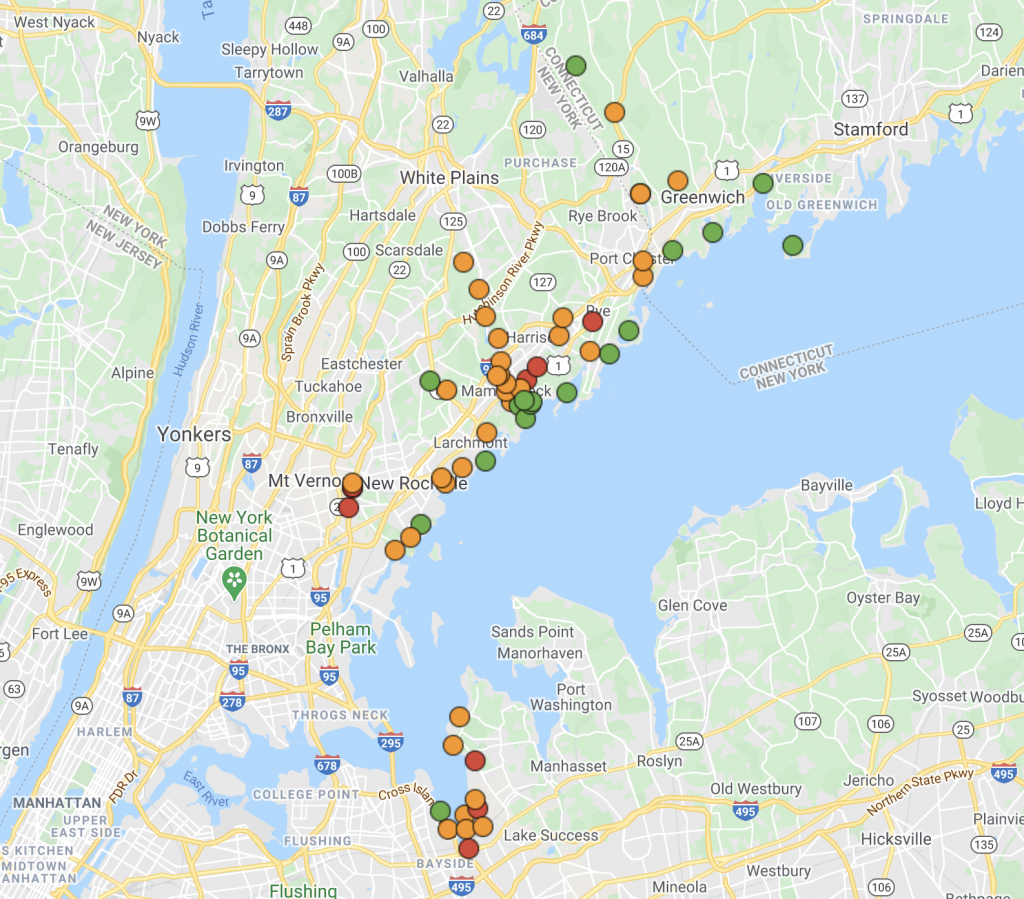
Click here to view interactive map and access the data sets
Overall fecal contamination rates only dropped 1% from the five-year high documented in 2019 (55% failure rate). Consistent with past years, contamination was higher after rainfall at most locations (60%).
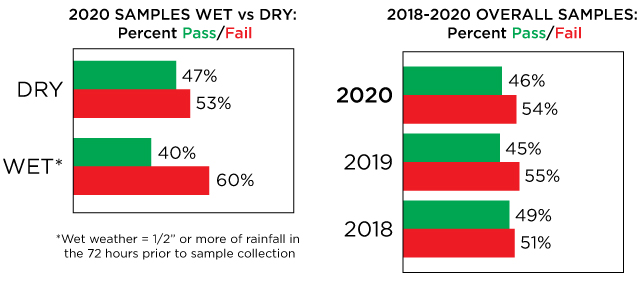
Rivers in Need of Attention
Numerous rivers monitored by Save the Sound have unacceptable fecal contamination, and the worst of those saw contamination levels rise in 2020. These rivers meander through communities and often do not appear polluted to the naked eye. The Hutchinson River, Beaver Swamp Brook, Mamaroneck River, and Blind Brook are consistently the worst rivers in the annual monitoring effort. In addition to the poor monitoring results, Save the Sound has documented and reported at least one illicit discharge of pollution in each of these rivers in the last five years.
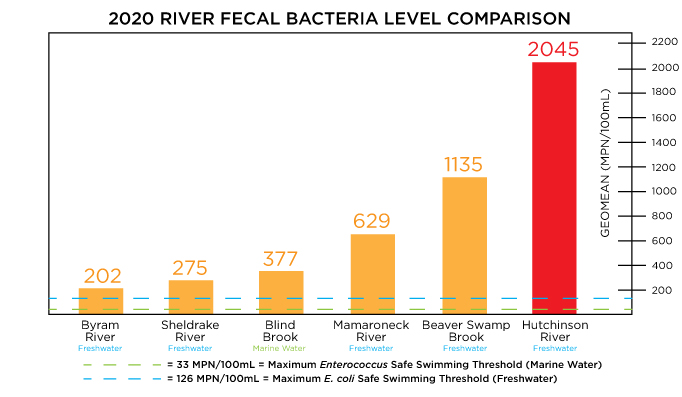
Click here to view interactive map and access the data sets
Dry weather samples collected at rivers had a 71% failure rate in 2020 which is notably higher than bays and harbors (“embayments”) and the Long Island Sound shoreline. Scientific findings have shown that degraded and leaky sewer lines can cause fecal contamination in waterways during dry weather. Sewer lines are engineered to run from high locations to lower ones wherever possible, using gravity to move wastewater to treatment plants, and often run alongside or very close to rivers and streams. Untreated sewage in these circumstances can ooze out of cracked pipes and into waterways such as the rivers sampled by Save the Sound.
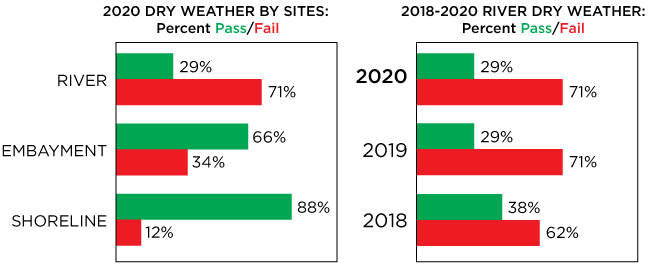
There was an alarming 80% failure rate of river samples collected during wet weather. Stormwater often carries fecal contamination and other pollutants into the nearest river or stream. Overloaded, collapsed, or blocked sewer lines will surcharge during rain, leaking untreated sewage into the stormwater system which drains to rivers and streams.
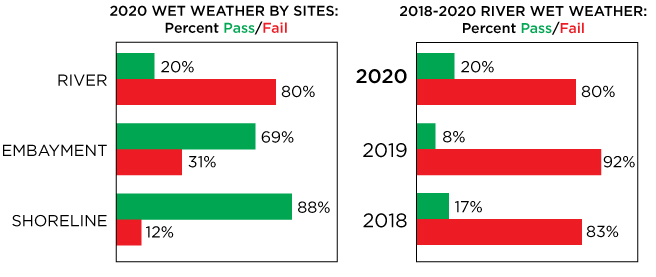
Click here to view interactive map and access the data sets
Save the Sound Legal Action
In 2015, Save the Sound filed a lawsuit for violations of the Clean Water Act against Westchester County and the following Sound shore municipalities: Harrison, Larchmont, Town of Mamaroneck, Village of Mamaroneck, New Rochelle, Pelham Manor, Port Chester, City of Rye, Rye Brook, Scarsdale, and White Plains. The lawsuit addresses the widespread state of disrepair of the underground sewer pipes and other parts of the sewer collection systems in these municipalities. For many years, these leaky collection systems have contributed to the poor water quality results documented in waterways along the Sound shore in Westchester County by Save the Sound, EPA, DEC and others.
As a result of this lawsuit 531 miles of local sewer lines have been inspected to date and 38,604 defects in those sanitary sewer collections systems have been identified for repair. The defendant communities are securing NY State grant funding to perform the needed repairs.
“The 2020 water quality data shows that coastal communities have yet to make a meaningful dent in the widespread sewage contamination issues in our region. We are encouraged, however, by the fact that many communities are now engaged in planning for and implementing repairs to aged and failing municipal sewage collection systems,” said Tracy Brown, regional director of water protection for Save the Sound. “We hope that proper maintenance will become a norm for these systems going forward and that our local water quality will improve, allowing for more safe swimming days that area residents deserve, and the eventual reopening of Westchester’s shoreline for shellfish harvesting.”
Best and Worst of 2020
Five sites in the study had no failing samples – Greenwich Cove, Larchmont Harbor, outer Mamaroneck Harbor, Rye Marshland Conservancy and the Byram River in Greenwich.
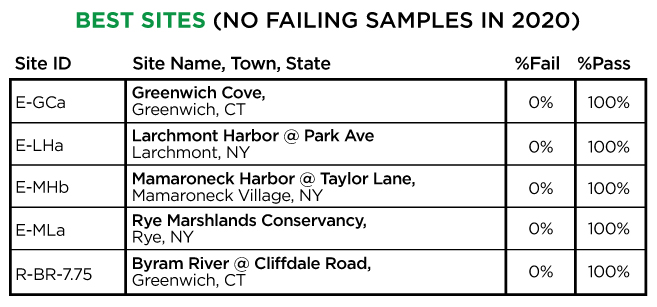
Eleven sites failed every time they were sampled including Udalls Mill Pond in Saddle Rock on Long Island, multiple sites on Beaver Swamp Brook, the Hutchinson River and the Mamaroneck River. The Hutchinson River is once again the most polluted river in the study, followed by Beaver Swamp Brook. Both recorded the highest pollution levels since Save the Sound started monitoring them in 2016.
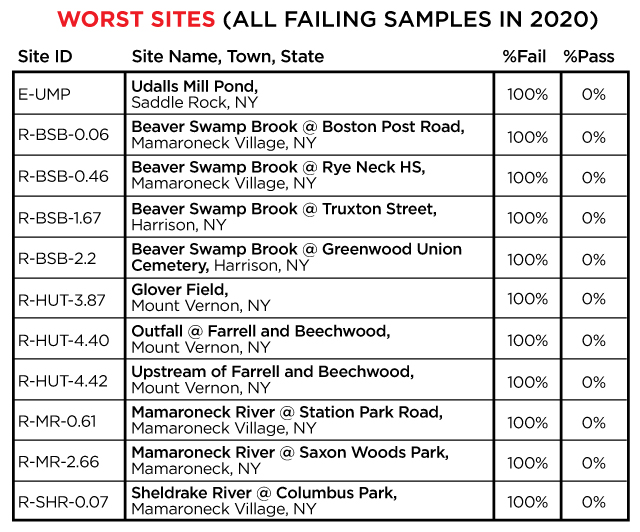
Click here to view interactive map and access the data sets
Save the Sound has an established 45-year track record of restoring and protecting the waters and shorelines of the Sound. From its offices in New Haven and Mamaroneck, Save the Sound works for a cleaner, healthier, and more vibrant Long Island Sound where humans and marine life can prosper year-round. Our success is based on scientific knowledge, legal expertise, and thousands of ordinary people teaming up achieve results that benefit our environment for current and future generations.
